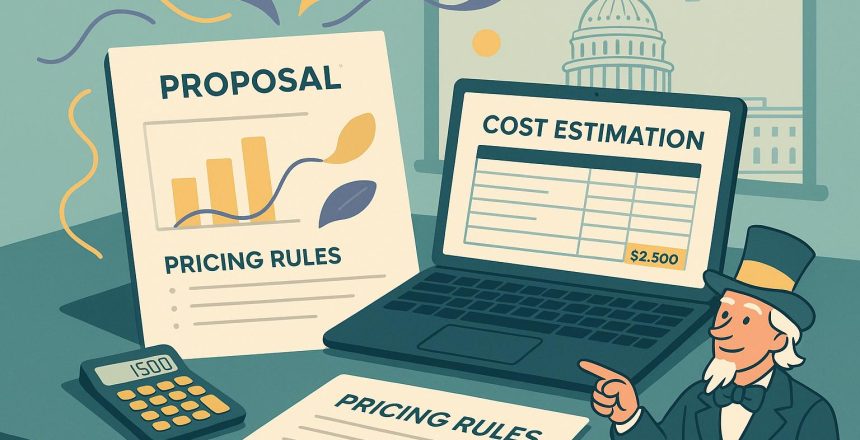Cost estimation for GSA proposals is critical for winning contracts and ensuring compliance with government pricing rules. Here’s what you need to know:
- Why It Matters: Accurate cost estimates help secure contracts, especially since only 4% of small businesses participate in GSA Schedules, and 44% of awards receive just one bid.
- Key Cost Elements: Break down costs into direct (labor, materials, equipment) and indirect (overhead, insurance, admin expenses) categories.
- GSA Pricing Rules: Follow fair market pricing, provide complete documentation, and maintain price consistency.
- Steps to Calculate Costs:
- Gather recent price data from sales records, market research, and cost history.
- List all cost components, including labor, materials, and overhead.
- Apply GSA pricing rules, such as Commercial Sales Practice disclosures and the Price Reduction Clause.
- Verify calculations against market standards and GSA guidelines.
- Avoid Common Mistakes: Don’t overlook overhead costs or rely on outdated market data.
Hiring GSA experts can save time, improve compliance, and increase your chances of approval, with a 98% success rate and potential revenue gains averaging $927,000 annually.
Main Cost Elements in GSA Proposals
Direct vs. Indirect Costs
Understanding the difference between direct and indirect costs is crucial for preparing accurate GSA proposals. Here’s a breakdown of the key cost components:
| Cost Type | Examples | Documentation Required |
|---|---|---|
| Direct Labor | Project managers, technicians, specialists | Labor categories and rates |
| Materials | Raw materials, components, supplies | Bills of materials |
| Equipment | Tools, machinery | Purchase or lease records |
Indirect costs, on the other hand, include expenses that support multiple contracts, such as facility costs, administrative salaries, and insurance. These classifications play a big role in determining profits and adjusting prices.
Profit Calculations and Price Rules
Once you’ve classified your costs, it’s time to determine your profit margins. These margins should balance commercial pricing with staying competitive. Key factors to consider include:
- The complexity of the contract and its base profit rate
- Risk levels tied to deliverables
- Order size and volume discounts for larger contracts
Contractors also need to comply with the Price Reduction Clause (PRC), which ensures adherence to GSA pricing rules.
Market Research Methods
After identifying your costs and setting profit margins, validate your pricing through detailed market research. Use these methods to ensure your pricing aligns with industry and government standards:
- Commercial Price Analysis: Review published price lists, recent sales data, and industry pricing databases.
- Government Contract Research: Use tools like the GSA Advantage! platform, Contract Award Notices, and the Federal Procurement Data System.
- Competitive Assessment: Study similar Schedule contracts, recent awards, and market pricing trends.
This thorough approach ensures your proposal is both competitive and compliant.
Develop a Winning Cost Proposal
4 Steps to Calculate GSA Costs
Accurate cost calculations are a must for crafting strong GSA proposals. Using the cost elements discussed earlier, follow these steps to ensure precise GSA estimates.
1. Gather Price Data
Start by collecting pricing information from various reliable sources:
| Data Source | Information Needed | Validity Period |
|---|---|---|
| Commercial Sales | Sales data from the past 12 months | Within 1 year |
| Market Research | Competitors’ current pricing | Within 6 months |
| Cost Records | History of direct and indirect costs | Within 2 years |
Keep a detailed record of all sources, including databases, dates, and specific price points.
2. List All Cost Components
Break down every cost element in detail:
- Direct Labor: Include hourly rates, benefits, and time allocations.
- Materials: Specify unit costs, quantities, and supplier details.
- Overhead: Factor in facility expenses, utilities, and administrative costs.
- Equipment: Account for depreciation, maintenance, and operating expenses.
- Insurance: Include liability coverage and worker’s compensation.
- Training: Add costs for certifications and ongoing education.
3. Apply GSA Price Rules
Follow GSA pricing requirements to align with contract terms:
- Complete the Commercial Sales Practice (CSP) disclosure.
- Clearly document any pricing deviations.
- Justify discounts as required by the contract.
- Ensure compliance with the Price Reduction Clause.
4. Verify All Calculations
Thoroughly review your calculations to avoid errors:
- Check calculations against source documents and current market rates.
- Cross-reference direct costs to ensure accuracy.
- Confirm allocations for indirect costs.
- Compare final prices to market standards.
- Ensure GSA formatting guidelines are met.
- Seek an independent review of your calculations for added accuracy.
sbb-itb-8737801
Common Cost Estimation Mistakes
Even seasoned contractors can slip up when creating GSA cost estimates. These errors can throw off your numbers and weaken your proposal.
Missing Overhead Costs
Leaving out overhead expenses skews your cost estimates. Overhead includes things like facility maintenance, software, and administrative support – key elements that need to be accounted for. Here’s how you can avoid this mistake:
- Track indirect costs with reliable accounting methods.
- Review past performance data to spot recurring overhead expenses.
- Document resource allocation to show how shared resources are used.
- Include both fixed and variable overhead in your calculations.
By following these steps, your proposals will better reflect actual costs. But there’s another issue to watch out for: outdated data.
Old Market Data
Relying on old market data can cause pricing errors and misaligned proposals. Staying up-to-date with market trends is crucial for competitive pricing and accurate cost assumptions. To prevent this:
- Keep market insights current by leveraging supplier channels and automation tools.
- Track major market changes as they happen.
Keeping your market data fresh ensures your cost estimates are accurate and align with GSA pricing standards.
Expert Help with Cost Estimates
Navigating the complexities of GSA proposal cost estimates can be tough. Expert guidance simplifies this process, ensuring accuracy and compliance.
Working with GSA Experts
GSA consultants bring specialized knowledge to the table, making it easier to handle pricing requirements and meet compliance standards. Their expertise is especially helpful for tackling tricky cost calculations and managing detailed documentation.
"We’re your ‘dedicated negotiators’ for GSA… We’ll make sure you get fair, lucrative and reasonable prices." – Josh Ladick, Founder, GSA Focus
Here’s how expert support benefits small businesses:
- Compliance Assurance: Specialists ensure your cost estimates meet GSA pricing rules.
- Documentation Support: Experts handle most of the paperwork, cutting your required time down to about 3 hours.
- Negotiation Expertise: Skilled negotiators work to secure the best possible pricing terms.
These benefits also translate into significant time savings, as detailed below.
Time-Saving Expert Services
Hiring professional GSA services can dramatically cut down the time and effort needed for proposal preparation. Here’s the impact of expert assistance:
| Benefit | Impact |
|---|---|
| Faster Processing | 4–6x quicker compared to DIY approaches |
| Success Rate | 98% contract approval rate |
| Revenue Potential | An average of $927,000 in additional yearly revenue |
| Client Time | Requires only 3 hours of your involvement |
Professional services include:
- Dedicated Negotiation: Acting as your authorized negotiators to secure favorable terms.
- Comprehensive Review: Detailed analysis of cost elements and pricing strategies.
- Ongoing Support: Continuous help with compliance updates and adjustments.
- Risk Reduction: Expert oversight to avoid costly mistakes.
Summary
Cost Estimation Review
Accurate cost estimates are the backbone of successful GSA proposals. To get it right, you’ll need to focus on a few key areas:
Key Cost Components:
- Direct, indirect, and overhead expenses
- Up-to-date market pricing
- Profit margins that align with GSA guidelines
Documentation Needs:
- Complete and detailed price documentation
- Recent market research
- Comprehensive cost breakdowns
- Evidence to back up all calculations
A careful review process is critical. Overlooking or underestimating overhead costs is a common mistake that can jeopardize your proposal.
Getting Professional Help
While these steps set the foundation, professional guidance can make the process much smoother. Experts can help ensure compliance and handle the bulk of the paperwork – up to 95% of it. Given that only 4% of small businesses currently hold GSA Schedule contracts, having professionals navigate the complexities can significantly improve your chances.
The results speak for themselves: clients often see an average 87x ROI. Benefits include ensuring compliance, providing thorough documentation, and negotiating pricing terms to your advantage. Expert support can be the game-changer for your GSA proposal success.
FAQs
What are the key mistakes to avoid when estimating costs for a GSA proposal?
When estimating costs for a GSA proposal, it’s crucial to avoid common mistakes that can lead to inaccuracies or compliance issues. Here are a few key pitfalls to watch out for:
- Underestimating Costs: Failing to account for all expenses, such as labor, materials, or indirect costs, can result in a proposal that doesn’t cover your actual expenses, leading to financial strain.
- Ignoring Market Research: Not benchmarking your pricing against competitors or federal standards can make your offer uncompetitive or non-compliant with GSA pricing guidelines.
- Overlooking Compliance Requirements: Ensure your cost estimates align with GSA’s terms, conditions, and pricing expectations to avoid rejection or renegotiation.
By addressing these issues, you can create a more accurate, competitive, and compliant GSA proposal, setting your business up for success in federal contracting.
How can working with GSA experts increase my chances of success and benefit my business financially?
Partnering with GSA experts, like those at GSA Focus, can greatly enhance the likelihood of your proposal’s success. Navigating the GSA Schedule process can be complex and time-consuming, but experienced professionals simplify it by managing documentation, ensuring compliance, and providing negotiation support.
Beyond improving your success rate, hiring GSA experts can deliver significant financial returns. On average, businesses see a substantial boost to their bottom line – potentially adding hundreds of thousands of dollars in federal contracting opportunities. With a proven track record and a high success rate, GSA experts can help maximize your investment and open doors to lucrative government contracts.
How can I make sure my pricing meets both market rates and GSA requirements?
To ensure your pricing aligns with both market rates and GSA standards, it’s important to strike a balance between competitiveness and compliance. Start by researching current market trends and evaluating what similar businesses charge for comparable services. Then, review GSA pricing guidelines to ensure your rates meet their requirements for fairness and reasonableness.
For small businesses, navigating this process can be complex. Specialists like GSA Focus can guide you through pricing negotiations, helping you secure rates that are both competitive and profitable while meeting GSA standards. Their expertise simplifies the process, ensuring your pricing strategy positions your business for success in the federal market.
Related posts
- Ultimate Guide to GSA Proposal Documents
- Ultimate Guide to GSA Proposal Errors
- How to Set GSA Prices for Federal Contracts
- Cost Element Breakdown in GSA Contracts


